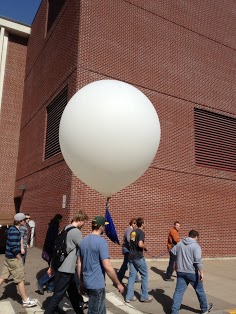Over the course of the semester, our class has spent a lot of time using balloons to collect aerial imagery of our campus. In addition to those mapping activities, we also created a rig for what we called the HABL (High Altitude Balloon Launch). This activity involved launchig a balloon into space while recording video of the flight. The balloon was to travel about 100,000 feet up until it popped due to the pressure. The parachute would then open up and bring the camera rig back down to surface.
Methods
The construction of the HABL rig began a few months ago, with design modifications occurring after some of the other balloon mapping exercises. Figure 1 shows the container used to house the camera for this activity made out of a styrofoam bait container. A hole was cut out of the bottom for the camera lense to take video during its flight. The rig also contained a water proof case for the camera, handwarmers to keep the camera from getting too cold, and a tracking device to that we could recover the rig after it came back down to the surface. Four strings were connected from the edges of the rig and tied together at the top.
 |
| Figure 1. Rig designed to house the video camera for HABL launch |
Figure 2 shows the balloon being walked to the balloon launching site in the middle of the campus mall. The balloon was filled from a large helium tank until it was about eight feet in diameter. We did not want to fill the balloon up too much because the balloon needs to expand as it gets to higher altitudes. After the balloon was filled to the desired amount, zip ties and duct tape were used to seal off the balloon. The rig containing the camera and parachute were then attached using carabiners. After watching the weather closely for a few weeks, the launch was finally scheduled for 10 AM on April 26.
 |
| Figure 2. Balloon being walked to the launch site |
http://desi.uwec.edu/Geography/Hupyjp/Weather_Balloon_1024.asx
As soon as the balloon was let go, winds immediately took it to the east. The tracking device stopped working (most likely from cool temperatures), but fortunatly about an hour and a half later we got a stationary signal indicating that the balloon had touched down. Our professor and a few students set out to retrieve the balloon rig which touched down near Marshfield, WI. Upon arrival, they found the rig stuck in a tree (Figure 3). Our professor climbing up the tree and cut one of the limbs off to retrieve the rig.
 |
| Figure 3. HABL rig stuck up in a tree |
Discussion
The HABL turned out to be a success, as we were able to collect some great video of its journey. In the course of an hour and a half, the balloon traveled about 100,000 feet up in the air and about 78 miles to the southeast. Figure 4 shows the distance traveled by the balloon rig.
 |
| Figure 4. Distance traveled by balloon rig |
 |
| Figure 5. Still shot from the camera of the campus footbridge |
 |
| Figure 6. Still shot of the Chippewa River to the east of Eau Claire |
 |
| Figure 7. Image at the peak of the HABL launch where the curvature of the Earth is visible |
Conclusion
This activity was really a culmination of efforts throughout the entire semester and was based on trial and error. Balloon mapping is not very widespread, so there was not much information about it, leaving us to work together make this activity work. I feel very fortunate to have been able to have been a part of something as an undergrauate student that not many people have a chance to participate in. Overall, I thought the aerial image gathering and HABL using balloons were some of the coolest projects I have been a part of in college. In the future, this class plans to include a GPS unit, thermometer, barometer, and anemometer to be able to gather more data during the flight.
No comments:
Post a Comment